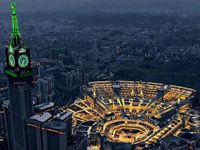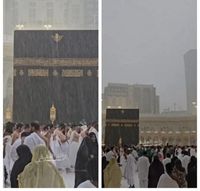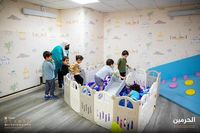Several areas in western Saudi Arabia, particularly Mecca, experienced heavy rainfall over the weekend of March 22-23, 2025, causing significant concern as the region prepares for the upcoming Eid Al Fitr festival. The rains, which began in early Ramadan, are expected to continue until March 29, according to a weather forecast by Aqeel Al Aqeel from the Saudi National Centre for Meteorology (NCM). This weather condition, involving moderate-to-heavy rainfall, is set to particularly affect the central and eastern highlands as well as the Mecca region, complicating the pilgrimage experience as millions of worshippers flock to the area.
NCM has issued warnings of thunderstorms, hail, and visibility-reducing winds throughout seven regions in the kingdom starting from March 23. Affected areas include the Eastern Province, Riyadh, Najran, Jizan, Asir, Al Baha, and importantly, Mecca. Active winds may also create sandstorm conditions in Al Qassim, Medina, and along coastal areas of Tabuk. Heavy rainfall impacted several areas in western Saudi Arabia, including Mecca, over the weekend, prompting concerns about the safety of worshippers.
Despite the inclement weather, a video shared by Mecca authorities showed devoted pilgrims continuing their rituals at the Grand Mosque, Islam's holiest site, amid heavy downpours. Last week, on March 17, the city of Jeddah suffered from severe flooding due to heavy rains, with footage circulating on social media depicting torrents of water inundating streets.
In response to the surge of worshippers, Saudi authorities have taken precautionary steps, urging Muslim pilgrims not to bring children to the Grand Mosque in the final days of Ramadan. The directive stems from safety concerns as visitor numbers peak during prayer times. The National Centre for Security Operations emphasized the importance of adhering to safety guidelines to ensure comfort amidst the heightened foot traffic. Although parents are urged to avoid bringing children, the General Authority for Care of the Two Holy Mosques assures that safe childcare centers are available at the mosque, functioning around the clock to provide a secure environment. The agency assured parents with a reassuring message: "Your children are in safe hands."
As Ramadan unfolds, the pressure on the Grand Mosque has intensified. The facility is currently witnessing the monumental effects of its recent third expansion, which comfortably accommodates over two million worshippers simultaneously. This expansion, one of the grandest architectural undertakings in the mosque's history, enhances the flow of visitors by widening entrances and implementing modern crowd control mechanisms, all while maintaining the sacred site's serenity.
Architectural advancements speak volumes about the care taken in this project, which features a total of 22 domes—12 motorized glass domes, six fixed glass domes, and four permanent domes situated in the central halls of the second floor. The most significant of these, a motorized dome that dominates the ceremonial corridor, spans 36 meters in diameter and rises 25 meters high, weighing in at approximately 800 tonnes. Its external finish boasts vibrant mosaics, while the internal ceilings showcase intricate wood inlays embellished with embedded gemstones.
The glass domes are specifically designed to provide natural ventilation, opening via a central control unit when suitable temperatures allow. Other fixed glass domes, each measuring 9 by 14 meters and reaching an impressive 35.5 meters in height, have been strategically placed throughout the second and mezzanine floors. The combination of aesthetic appeal and practical function, found in features like polished marble finishes and lavish stained glass openings, ensures that visitors enjoy a unique experience of reverence and comfort during their prayers.
Assisting this monumental operation is a dedicated workforce comprising engineers, technicians, supervisors, and maintenance workers, who operate 24/7 to ensure everything runs smoothly. Their roles encompass logistical coordination, technical monitoring, cleanliness, and managing the movements of always-bustling crowds. This level of preparation aims to deliver an experience of ease, reverence, and safety for all visitors.
As pilgrims prepare for Eid Al Fitr, expected on March 29, the interplay between challenging weather and impressive infrastructural developments at the Grand Mosque sets a dramatic backdrop. The excitement of the festival, along with the reverence of Ramadan, remains palpably strong despite worries over safety and weather conditions.



